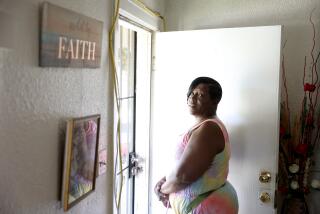A Shameful Child System
The children who most need help are being the most ill-served by the child welfare system in California. As three articles by Tracy Weber in The Times showed last week, judges, social workers and lawyers are all overworked, unable to give the time needed to toddlers and teenagers whose parents cannot or will not care for them or, worse, have beaten, raped or tortured them.
The series focused on Orange County, which long ago shed its status as suburbia and took on the problems of urban areas everywhere. That county has experienced a disturbing rise in the number of child abuse cases in this decade. But counties up and down California are not strangers to an overworked system.
Last year the Los Angeles County Grand Jury delivered a blistering report on the county’s nearly 500 group homes for children. These supposedly nonprofit homes house the most abused or neglected foster children and are paid as much as $60,000 per year per child. Still, in many cases the grand jury found that food was bad, clothes were in short supply, children were drugged for dubious reasons and some were slapped and hit by caregivers.
In Ventura County, the county’s own facility for abused and neglected children, Casa Pacifica, was found so deficient in its care last year that the state Department of Social Services recommended revoking its license. County officials recommended sweeping changes to fend off the revocation.
Some experts say that early intervention to keep a family together would be better. It would require more money in the beginning, because more social workers would be needed to make frequent visits to homes to ensure that children were being properly fed and clothed and not abused. But it would be cheaper than waiting until children were so traumatized that they had to be taken from their families and housed in a group home at a cost to taxpayers of $60,000 a year per child.
But money is far from a cure. Society has to do better by its children. The longer the abuse and neglect, the worse off the child, the less likely a successful adoption or placement in foster care. Too often children proceed through a series of group homes until they are 18, when they are put onto the streets, uneducated, penniless, unequipped to do anything but repeat their parents’ mistakes.
Orange County social workers say that more than 1,000 children are in group homes where they are too often forgotten. Nearly one child in five has spent more than five years in the child welfare system. Some have never lived anywhere else. One official calls the nonprofit facilities “warehouses,” with proprietors who merely keep kids alive until they’re 18.
Only four Orange County social workers monitor 200 group homes. State officials check for health and safety violations once a year unless they receive a complaint. In several homes, predatory youngsters have physically or sexually abused weaker or younger residents. One group home was shut down last summer because there were so many problems.
There have been piecemeal attempts to patch the child welfare system in California, usually after a child dies. What’s needed is an integrated approach, with social workers, judges and caregivers in each county talking with each other and counties swapping information on what works. There ought to be stricter oversight and strong consequences, up to and including criminal prosecution, for group homes that mistreat or fail children. The state should take the lead. Do the math and see where there’s money to bolster the system, especially now with a booming economy.
We need these youngsters to become adults with education and skills, so that they do not go from one form of dependency to another. Too often, a pattern of abuse in childhood is a gateway to an adult life of crime, drug abuse, mental illness or homelessness.
These are our society’s children--and our collective responsibility. They deserve hope and a future, not abuse and neglect, in an environment designed to protect them.
More to Read
Sign up for Essential California
The most important California stories and recommendations in your inbox every morning.
You may occasionally receive promotional content from the Los Angeles Times.










